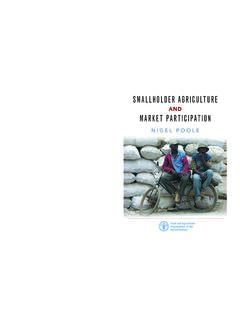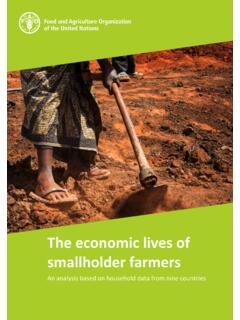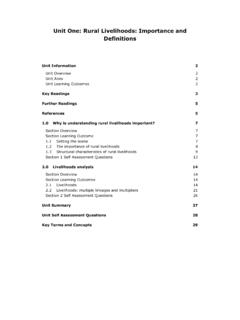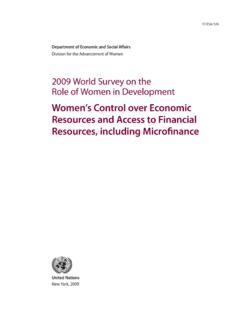Transcription of Agricultural productivity in Kenya: barriers and opportunities
1 The K4D helpdesk service provides brief summaries of current research, evidence, and lessons learned. Helpdesk reports are not rigorous or systematic reviews; they are intended to provide an introduction to the most important evidence related to a research question. They draw on a rapid desk-based review of published literature and consultation with subject specialists. Helpdesk reports are commissioned by the UK Department for International Development and other Government departments, but the views and opinions expressed do not necessarily reflect those of DFID, the UK Government, K4D or any other contributing organisation. For further information, please contact Helpdesk Report Agricultural productivity in Kenya: barriers and opportunities Izzy Birch December 2018 Question What are the most significant barriers to and opportunities for increasing long term sustainable Agricultural productivity in Kenya?
2 Please investigate where possible: 1. barriers and opportunities that factor broader concepts such as climate change, urbanisation, or population growth. 2. Reasons for the decline or stagnation of Agricultural productivity in Kenya in recent years, relative to neighbouring countries. 3. barriers and opportunities across the entire value chain, rather than just at-farm. Contents 1. Executive summary 2. Overview of the agriculture sector in Kenya 3. barriers to Agricultural productivity 4. opportunities to increase Agricultural productivity 5. References 2 1. Executive summary The principal barriers to Agricultural productivity in Kenya are clustered in six areas: Land and population pressures: Average farm size is falling and land distribution is becoming more concentrated, leading to significant constraints on production, particularly for smallholders.
3 Agricultural research and development and Agricultural extension1: The proportion of farmers accessing extension advice is low, while extension services tend to favour wealthier farmers. Government spending on Agricultural research has fallen steadily over the past decade. Markets: Government intervention in cereal markets distorts production and diverts resources from investments that might be more effective and efficient in improving productivity . While physical access to markets has generally improved, farmers report a number of institutional barriers and transaction costs related to market information and marketing processes. Access to credit is a constraint across the sector. Climate change: Changes in temperature and in the variability of rainfall are likely to have significant effects on Agricultural production, but impacts may be different for different crops.
4 Soil fertility and land degradation: Adoption of sustainable land management practices is low, and land degradation increasing. Public expenditure: Kenya is not meeting African Union commitments on public spending in agriculture , and spends less than its immediate neighbours. Its subsidy schemes are regressive and distortionary. Some of the opportunities to increase Agricultural productivity concern the following: Re-orienting public expenditure from private to public goods, particularly to Agricultural research and development, extension and training, and measures that reduce market transaction costs. Farmer-centred approach: The knowledge of farmers themselves is often overlooked. There is also an association between women s empowerment and productivity . New forms of farmer organisation may be required.
5 Farmer services: Index insurance in the agriculture sector is expanding and demonstrating results, as are digital technologies that facilitate market access. Measures to bring financial and Agricultural markets closer together could improve productivity . The scope of this report does not include the livestock sub-sector. Pastoral and agro-pastoral livestock production is covered in a separate report. No good quality information about the relationship between Agricultural productivity and devolution since 2013 was found. 1 Agricultural extension is the application of scientific research and knowledge to Agricultural practices through farmer education. See for example: 3 2. Overview of the agriculture sector in Kenya The agriculture sector contributes 51 percent of Kenya s GDP (26 percent directly and 25 percent indirectly) and accounts for 60 percent of employment and 65 percent of exports (World Bank, 2018, p.)
6 35). The sector is dominated by smallholder production on farms of between and 3 hectares, which account for 78 percent of total Agricultural production and 70 percent of commercial production (World Bank, 2015, pp. 2-3). Agricultural GDP is driven by horticulture and cash crops, but productivity is low, particularly for cereals. Given that most of the poor are in the agriculture sector, productivity also matters for poverty reduction. agriculture sector growth accounted for the largest share of poverty reduction between 2005 and 2015 (World Bank, 2018, pp. 20, 35). Historical analysis of Agricultural total factor productivity in sub-Saharan Africa shows that Kenya was one of the few countries to record steady, if modest, long-term growth between 1961 and 2008 (Fuglie and Rada, 2013, pp.
7 15, 37). However, there are concerns that productivity is declining: maize yields per hectare were lower in 2014 than in 1994 (World Bank, 2018, p. 35). Between 1990/92 and 2014/16, Kenya was one of the few countries in sub-Saharan Africa to experience an overall decline in maize yields (Wiggins, 2018, p. 27). More positively, Kenya s horticulture sub-sector continues to record dynamic growth (Matchmaker Associates, 2017). Table 1 provides a selection of data from Kenya, Ethiopia and Uganda, illustrating changes over time and comparisons between countries. Some striking features are the scale of government expenditure in Ethiopia, compared with Kenya and Uganda, and that both Ethiopia and Uganda have overtaken Kenya in terms of cereal yield. Table 1: agriculture sector indicators, Kenya, Ethiopia and Uganda 1995 2005 2016 Kenya Ethiopia Uganda Kenya Ethiopia Uganda Kenya Ethiopia Uganda Population (total, millions) Rural population (total, millions) Government expenditure on agriculture (% total outlays) - - - Employment in agriculture (%) agriculture value added per worker (constant US$) 1,496 281 664 1,868 321 656 2,013 538 575 agriculture , value added (% GDP) 26 52 37 21 42 27 33 34 23 Cereal yield (kg/hectare) 1,753 1,034 1,571 1,646 1,361 1,574 1,628 2,325 2,019 Source: 2 Figure for 2014.
8 4 3. barriers to Agricultural productivity Demographic and land pressures Sub-Saharan Africa is the only region of the world where the rural population will continue to grow beyond 2050 (Jayne et al, 2017, p. 3). Figures 1 and 2 compare Kenya s overall population growth and rural population growth with that of other countries in sub-Saharan Africa. In common with most other countries on the continent, the number of Kenyans employed in farming continues to increase in absolute terms, but is falling as a share of the workforce (Yeboah & Jayne, 2016, p. 15). Figure 1: Population growth, 1990-2015 Figure 2: Rural population growth, 1990-2015 Source: Wiggins, 2018, p. 23 The average age of the Kenyan farmer is widely referred to as being 60 years, although the original source for this statistic has not been found in the time available for this An alternative perspective is offered by Jayne et al (2017, pp.)
9 16-18) in their cross-country study on the future of work in African agriculture . Drawing on census data, they calculate that the mean age of Kenyans above 15 years engaged in agriculture rose from 35 in 1999 to 37 in 2009. Of the nine countries studied, three had experienced a small increase in the mean age, three a small decrease, and three were stable. 3 Some media articles attribute it to FAO. The FAO Country Programming Framework for Kenya, 2014-2017, mentions a figure of 55 years (p. 9), the source for which is given as a September 2017 article on The Young Agropreneur blog. 5 Whatever the actual figure, young people in rural areas of Kenya face particular challenges associated with population growth and land pressures.
10 For example, by the late 1990s in Nyeri, land was no longer possible as an inheritance, leading parents to substitute education for land as an endowment to their children (Keats & Wiggins, 2016, p. 52). Around one-quarter of young Kenyans start their family lives without having inherited any land from their parents (Yeboah & Jayne, 2016, p. 50). An increase in the average age of farmers may be a consequence not only of young people leaving the sector but of older people moving in. The fastest growing segment of the population entering farming is urban investors above 45 years (Table 2). Table 2: Changes in primary employment of working age population in Kenya # people in working age population Annual % change in # working age population in age categories 1999 2009 Annual % change 15-24 25-34 35-44 45-54 55-64 Urban Male 199,500 290,280 Female 295,820 547,510 Rural Male 2,345,220 2,423,090 Female 3,217,540 3,229,510 Source: Drawn from Yeboah & Jayne, 2016, p.
















